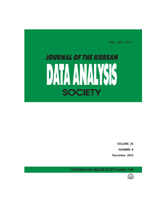한반도 집중호우 모의를 위한 심층 합성곱 생성적 적대 신경망의 강우 임계 설정에 관한 연구
Study on Rainfall Threshold Setting for Deep Convolutional Generative Adversarial Networks in Simulating Heavy Rainfall over the Korean Peninsula
- 한국자료분석학회
- Journal of The Korean Data Analysis Society (JKDAS)
- Vol.26 No.6
-
2024.121817 - 1834 (18 pages)
-
DOI : 10.37727/jkdas.2024.26.6.1817
- 21

기상 이변으로 인해 증가하는 극한 호우 피해에 효과적으로 대응하기 위해서는 호우 주의보 및 경보 발령 기준이 되는 강우량을 정확히 추정하는 것이 매우 중요하다. 본 연구는 한반도 전역의 5km 공간 해상도를 가진 일누적 강우량 자료를 활용하여 한반도 집중호우인 장마와 태풍에 따른 극한 강우 패턴을 모의하는 것을 목표로 한다. 먼저, 극한 강우 자료의 특성을 정확히 반영할 수 있는 최대 임계값을 도출하였고, 이를 기반으로 극한 강우 사건을 모의하기 위해 심층 합성곱 생성적 적대 신경망(DCGAN)을 제안하였다. 생성된 강우 이미지의 품질 평가는 FID(Frechet Inception Distance), 재구성 손실(reconstruction loss), MAPE(Mean Absolute Percentage Error) 등의 평가 지표를 사용하였다. 분석 결과, 강우 발생 사건 수의 상위 0.01%를 임계값으로 설정하는 것이 손실된 정보를 효과적으로 절충(trade-off)하는 데 가장 적절한 것으로 나타났다. DCGAN 모델은 장마와 태풍 상황에서 정량적 강우 추정에 유용한 것으로 분석되었으며, 특히 200mm/day 이하의 강우 사건 모의에서 기존 모델에 비해 모든 지표에서 우수한 성능을 보였다. 생성된 이미지는 국지적 강우 패턴을 충실히 반영하여 특정 지역에서 발생할 수 있는 자연재해의 가능성을 예측하고 대비하는 데 유용한 정보를 제공할 수 있을 것으로 기대된다.
To effectively respond to the increasing damage caused by extreme rainfall due to climate change, it is crucial to accurately estimate the rainfall threshold that triggers heavy rain advisories and warnings. This study aims to simulate extreme rainfall patterns associated with monsoons and typhoons over the Korean Peninsula by using daily cumulative rainfall data with a 5km spatial resolution. First, a maximum threshold was determined to represent the characteristics of extreme rainfall data best and a Deep Convolutional Generative Adversarial Network (DCGAN) model was proposed to simulate such extreme rainfall events. The quality of the generated rainfall images was evaluated using metrics such as Frechet Inception Distance (FID), reconstruction loss, and Mean Absolute Percentage Error (MAPE). Analysis results indicated that setting the threshold at the top 0.01% of rainfall events achieved the most effective trade-off in preserving information. The DCGAN model proved useful for quantitative rainfall estimation in monsoon and typhoon scenarios, showing superior performance across all metrics, especially for events with rainfall amounts below 200mm/day, compared to conventional models. The generated images effectively captured localized rainfall patterns and are expected to provide valuable information for predicting and preparing for potential natural disasters in specific areas.
1. 서론
2. 연구방법
3. 연구자료
4. 연구결과
5. 결론 및 시사점
References
(0)
(0)